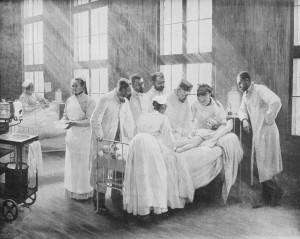Historically,
women around the world have tried to end their unplanned pregnancies whether
abortion is legal or not, often putting in risk their own safety and health by
self-inducing or seeking a dangerous illegal procedure. Estimates of the
annual number of illegal abortions in the United States during the 1950s and
1960s range from 200,000 to 1.2 million. Prior to Roe v. Wade, as many as 5,000
American women died annually as a direct result of unsafe abortions. Today,
abortion is one of the most commonly performed clinical procedures in the
United States, and the death rate from abortion is extremely low: 0.6 per
100,000 procedures.
Abortion Laws In The 1800s
In
the mid-to-late 1800s states began passing laws that made abortion illegal. The
motivations for anti-abortion laws were different from state to state. One of
the reasons included fears that the population would be dominated by the
children of newly arriving immigrants, whose birth rates were higher than those
of "native" Anglo-Saxon women. All medical practices during the 1800s
were extremely risky, all surgical procedures, including abortion, Hospitals
were not common during these times and antiseptics were unknown, and even the
most respected known doctors had only some medical educations. Without today's
current technology, maternal and infant mortality rates during childbirth were
extraordinarily high. The dangers from abortion were similar to the dangers
from other surgeries that were not outlawed.
Legalization in the Late 1960s
Between
1967 and 1973 one-third of the state’s liberalized or repealed their criminal
abortion laws. However, the right to have an abortion in all states was only
made available to American women in 1973 when the Supreme Court struck down the
remaining restrictive state laws with its ruling in Roe v. Wade. The 1973
Supreme Court decision in Roe v. Wade made it possible for women to get safe,
legal abortions from well-trained medical practitioners. This led to dramatic
decreases in pregnancy-related injury and death. Roe v. Wade ruled
unconstitutional a state law that banned abortions except to save the life of
the mother. The Court ruled that the states were forbidden from outlawing or
regulating any aspect of abortion performed during the first trimester of
pregnancy, could only pass abortion regulations reasonably related to maternal
health in the second and third trimesters, and could pass abortion laws
protecting the life of the fetus only in the third trimester. Even then an
exception had to be made to protect the life of the mother. Controversial from
the moment it was released Roe v. Wade politically divided the nation more than
any other recent case and continues to inspire heated debates, politics, and
even violence today. Though by no means the Supreme Court's most important
decision, Roe v. Wade remains it’s most recognized.
Today
Studies from June 2013
show that out of the fifty states there are still nineteen states where abortion
is completely illegal. All this is interesting to me because I see how people
have felt about abortion throughout the years and how some things have changed.
I feel that every woman should have the choice about what they should do about their
own pregnancy. No one should have the right to tell a woman she has to have a
kid because they are not the ones who are going to birth the baby or raise the
child. This issue intersects with my own body because I want to know that I have
to choice to have an abortion if that was what I felt was necessary.
Works Cited
"Abortion Laws Worldwide." Women on Waves. N.p., n.d. Web. 01 May 2014.
Krishnan, Shweta. "The Hegemony Of The Male Doctor." The ASAP Blog. N.p., 7 May 2013. Web. 02 May 2014.
Press, Kevin Mcgill Associated. "Court Hears Arguments on Mississippi Abortion Law." ABC News.
ABC News Network, 28 Apr. 2014. Web. 02 May 2014.
"Roe v. Wade (1973)." PBS. PBS, n.d. Web. 30 Apr. 2014.
Sullivan, Sean. "Where All 50 States Stand on Abortion, in Two Charts." Washington Post.
The Washington Post, 07 Mar. 2013. Web. 02 May 2014.


.jpg)
No comments:
Post a Comment